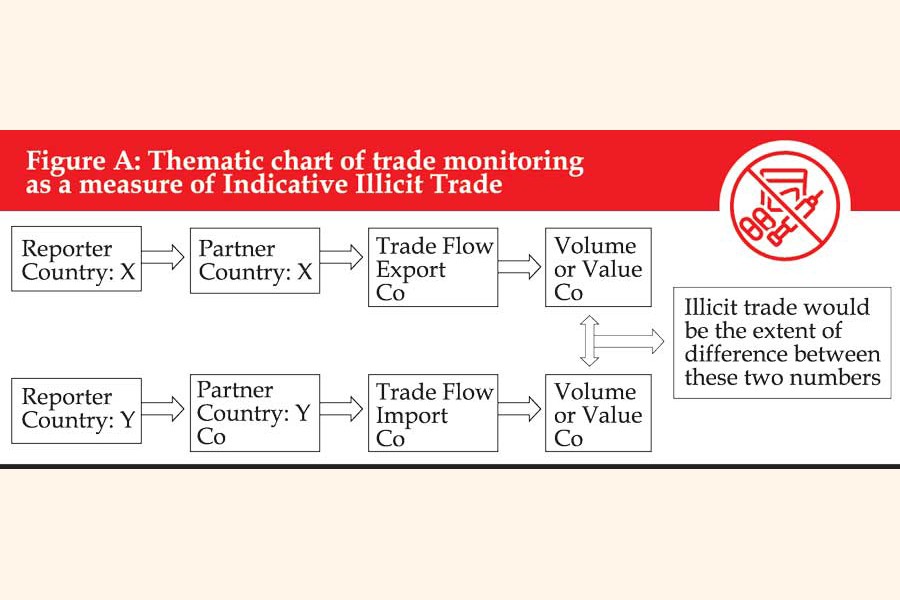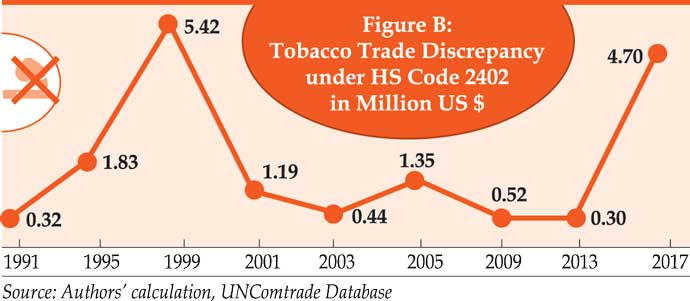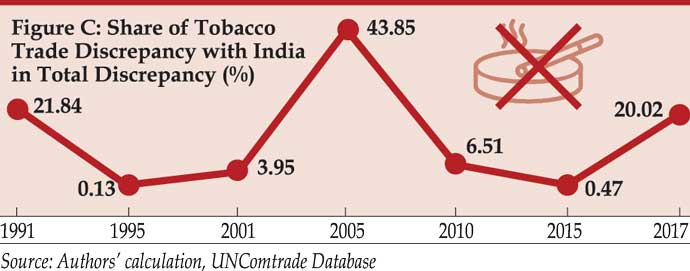SM Abdullah, Nahian Azad Shashi and Rumana Huque | November 24, 2019 00:00:00

 Effectiveness of tobacco control initiatives is subject to the status of trade regulations of a region. As a direct effect of trade liberalisation by many countries, the world has experienced stimulation in trade volume of tobacco and tobacco products in recent years. Reduction in trade barriers might increase possibility of tobacco marketing and reduce their price causing higher consumption of tobacco (Chaloupka and Laixuthai, 1996). This effect of liberalisation on consumption is more prominent in low and middle income countries (LMIC) than their high-income counterparts (Taylor et al., 2000, Bettcher et al., 2001).
Effectiveness of tobacco control initiatives is subject to the status of trade regulations of a region. As a direct effect of trade liberalisation by many countries, the world has experienced stimulation in trade volume of tobacco and tobacco products in recent years. Reduction in trade barriers might increase possibility of tobacco marketing and reduce their price causing higher consumption of tobacco (Chaloupka and Laixuthai, 1996). This effect of liberalisation on consumption is more prominent in low and middle income countries (LMIC) than their high-income counterparts (Taylor et al., 2000, Bettcher et al., 2001).
Similar to licit trade of tobacco validated by trade openness among countries, presence of illicit trade in the sector also enhances easy accessibility of tobacco products by undercutting tobacco prices. The extent of illicit trade, therefore, possesses a complex and pressing challenge for effective control of tobacco in any country.
Empirical estimation of the extent of illicit trade in tobacco market often remains as an intricate task because of its stealthy nature. Tobacco researchers around the world quite often triangulate several methods to improve preciseness of measurement of magnitude of illicit trade.
Monitoring trade: A simple exercise
Monitoring export and import data for tobacco products can help receiving estimate of illicit trade in country level (Merriman, 2013). In practice each country records volume and value of exports and imports of tobacco products by country of destination and origin. For ease of understanding, assume that country X and Y are bilateral trade partners who exchange tobacco along with other products. Country X's export destination for tobacco is country Y while country Y's import origin for tobacco is country X. Theoretically, country X's reported value of export should be equal to the country Y's reported value of import for tobacco. Nevertheless, in reality, since reported value of export and import often vary, this match has been observed rarely. The extent of discrepancy can be thought of as indicative for illicit trade.
The shortcoming of this method is that it is not designed to address the issue of 'bootlegging' (legal purchase of cigarettes in one place followed by consumption or resale in another place without paying proper taxes or duties) and relies on the assumption that entire discrepancy in the reported volume of tobacco products has been smuggled into the destination country. Despite the limitations, this method has been widely accepted as it is based on reliable data.
Glimpse of Bangladesh on Tobacco Trade: Application of Trade Monitoring
In Bangladesh, 35.3 per cent of adults (38 million) use tobacco regularly. They are spending, on an average, around Tk 1,078 every month (approximately US$13) for cigarette consumption (GATS Report, 2017).
 In response to this demand, the overall use of land for tobacco cultivation and hence the overall production of tobacco has been on an increasing trend. During 2009-10 to 2017-18, the average amount of land that has been devoted to tobacco cultivation was around 116,000 acres per year with an average production of 82,000 tonnes of tobacco leaf. On an average, the land under tobacco cultivation grew at around 2.0 per cent every year while the rate for production of tobacco leaf was around three and half times more (Yearbook of Agricultural Statistics 2012 and 2018, Bangladesh Bureau of Statistics). Keeping aside the internal production scenario of tobacco market in Bangladesh, there is lack of evidence on how much accurately external source adding to the total actual supply of tobacco.
In response to this demand, the overall use of land for tobacco cultivation and hence the overall production of tobacco has been on an increasing trend. During 2009-10 to 2017-18, the average amount of land that has been devoted to tobacco cultivation was around 116,000 acres per year with an average production of 82,000 tonnes of tobacco leaf. On an average, the land under tobacco cultivation grew at around 2.0 per cent every year while the rate for production of tobacco leaf was around three and half times more (Yearbook of Agricultural Statistics 2012 and 2018, Bangladesh Bureau of Statistics). Keeping aside the internal production scenario of tobacco market in Bangladesh, there is lack of evidence on how much accurately external source adding to the total actual supply of tobacco.
According to Bangladesh's Country Profile under Tobacco Control Economics in World Health Organisation (WHO), India, USA, the Netherland, Belgium, Republic of Korea, Germany, Brazil, Zimbabwe and Portugal were the main tobacco trade partners for Bangladesh. The presence of Singapore, UK and China in the list has also been spotted consistently during recent times. Belgium and Indonesia appeared in frequently.
 It is historically evident that the partner list has always been under constant change with one exception having the consistent presence of India over the years. Thus, scrutiny of the trend of total tobacco trade data for Bangladesh along with the trend involving India can reveal some important features of tobacco trade in the country, especially because it shares a large land border with India.
It is historically evident that the partner list has always been under constant change with one exception having the consistent presence of India over the years. Thus, scrutiny of the trend of total tobacco trade data for Bangladesh along with the trend involving India can reveal some important features of tobacco trade in the country, especially because it shares a large land border with India.
The United Nations Commodity Trade (UN Comtrade) – International Trade Statistics database has been used as data source. As the data exist on bilateral level, they allowed us to compare a country's import value in US dollar, with its trading partner's reported value of export for a commodity. The value of import of tobacco under Harmonised System (HS) code 2402, and the value of export of tobacco to Bangladesh reported by different trading partners under the same HS code had been collected for the period 1991 to 2017. For estimating total discrepancy for each year, trade data of all countries involved in tobacco trading with Bangladesh for that year had been used. The standard definition of HS code 2402 includes Cigars, Cheroots, Cigarillos and Cigarettes of tobacco or of tobacco substitutes.
As Bangladesh's reported import value is subtracted from exporter country's reported export value, a positive discrepancy value suggests a case of underreporting. On the other hand, negative discrepancy value indicates over reporting. Most countries do not have export duties and taxes on tobacco products but have import duties and taxes. Thus, it is importers, who have incentive to do underreporting. A practice of under-reporting thus might be an indication for illicit tobacco trading activities. However, a large share of discrepancy may be an indicator of smuggling activity during trade. Besides a consistent pattern on the discrepancy would be alarming as it would indicate the feebleness of law enforcement which in turn contains worse implication for revenue collection of the government and effectiveness of tobacco control initiatives.
Figure B shows trend of total tobacco trade discrepancy in million US dollar for Bangladesh. Starting from a tobacco trade discrepancy as low as US$0.32 million in 1991, it reached to as high as US$4.70 million in 2017. However, there was period of booms and busts over the last two and a half decades. In early 1990s, the tobacco trade underreporting in Bangladesh was on the high tide and in late 1990s the wave was high enough to touch the highest possible number with US$5.42 million in the recent history. The exporting countries were reporting the amount; in contrast the amount reported by Bangladesh sometimes observed to be lower than the reported export amount and quite surprisingly sometimes was completely unobserved. For instance, during '90s there was no observed reported amount of tobacco trade in the year 1994 and 1998. In the recent times the similar practice happened for the year 2014, 2016 and 2017. Partner-wise data scrutiny revealed that during the mentioned years although India, Singapore, China, the Netherlands, Germany and Republic of Korea reported tobacco export to Bangladesh, there was no reporting amount of import against those partners by the country. This might have considerable implications in terms of loss of government revenue.
Since 2005, different tobacco control initiatives through policy and action came into play after signing and ratification of Framework Convention on Tobacco Control (FCTC). It has been observed that there were relatively very small waves of underreporting with a value of about less than a million US dollars over the period 2005-2013. This declining trend continued indicating better efficiency in record keeping and governance till the early years of current decade. Nevertheless, since 2013 the wave of underreporting in tobacco trade started rocketing and reached to a value of US$4.70 million at the end of 2017.
Therefore, the amount of revenue loss for the government would be substantial if this pattern continues. Along with revenue loss, this would further increase the availability, affordability and hence the use of tobacco products. All these are going to worsen the tobacco control initiative despite the high level of commitment of the present government to tobacco control.
Figure C presents the trend of share of tobacco trade discrepancy with India in total discrepancy since 1991. It provides evidence that during first half of 1990s the share of tobacco trade discrepancy with India in Bangladesh's total tobacco trade discrepancy declined sharply. By the end of second half it increased moderately to reach at 3.95 per cent in 2001. Nevertheless, during the early years of last decade this share alarmingly skyrocketed and touched its peak ever in the history with a value of almost 44 per cent. This underreporting of tobacco trade with India has come under control and experienced a declining trend since 2005 to reach at a level as low as less than 1 per cent by the end of 2015. The concerned feature of this story is that during the recent time since 2015 it again started accelerating along with acceleration of underreporting in total tobacco trade.
Hence, it can be argued from the above scenario that at least in recent times there is a co-movement in the share of Bangladesh's discrepancy with India as partner and the country's total tobacco trade discrepancy. While deliberate underreporting might generate rent to a particular group, it is understandable that this reporting discrepancy might be the sole result of sloppiness of the system. This is regardless of the fact that the country needs to get rid of it for the betterment of expected revenue generation and success for tobacco control. The issue needs keen attention from the policymakers and demands further research.
Fighting tobacco epidemic indeed would require adopting a holistic tobacco control approach. Curbing prevalence further would be subject to successful intervention for demand control as well as control in supply. As supply-side intervention, ensuring successful law enforcement and strict monitoring on the tobacco producers, use of more effective tax stamps, efficient and effective data recordkeeping and tracking system of production and distribution of all types of tobacco products would reduce illicit supply and hence help reduce tobacco consumption. Effective tracking and tracing system for proper implementation of the FCTC protocol on illicit trade would be the key to addressing the concern over illicit supply of tobacco products.
Dr. Rumana Huque and SM Abdullah are faculty members at Department of Economics, the University of Dhaka, and Nahian Azad Shashi is research associate at Bangladesh Institute of Development Studies (BIDS). abdullahsonnet@gmail.com
rumanah14@yahoo.com
nahianazad2016@gmail.com
© 2025 - All Rights with The Financial Express
